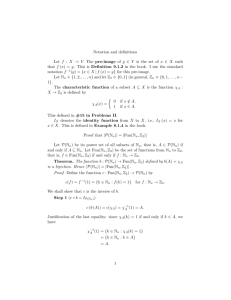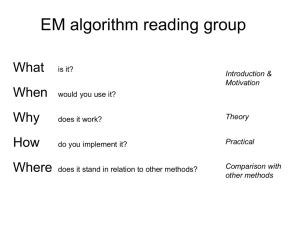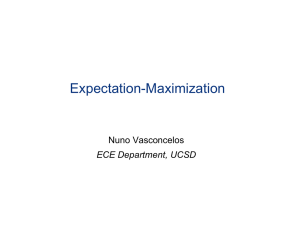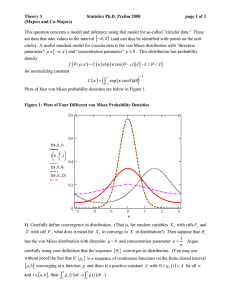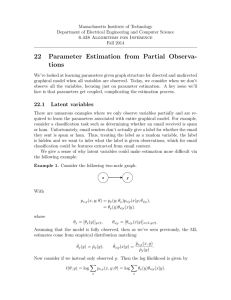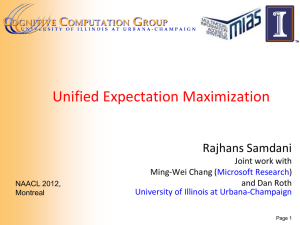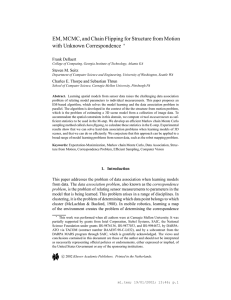Missing Data and the EM Algorithm X µ Σ
advertisement
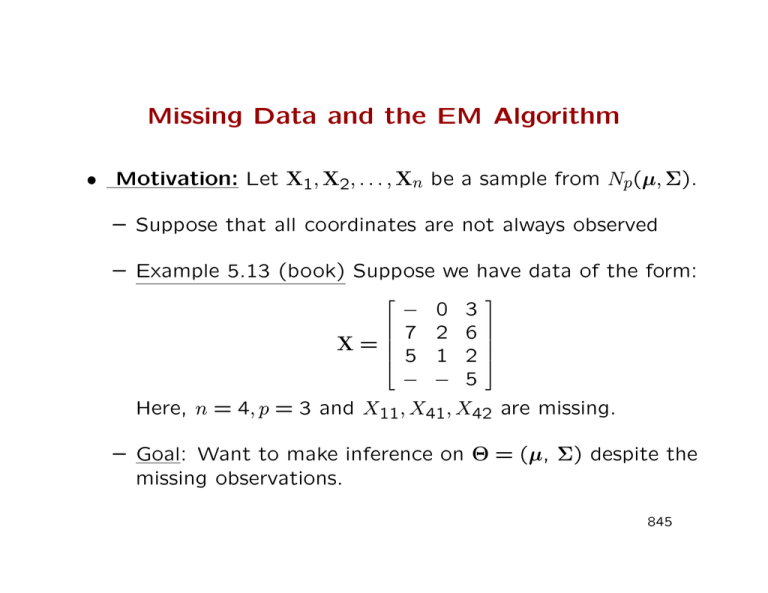
Missing Data and the EM Algorithm • Motivation: Let X1, X2, . . . , Xn be a sample from Np(µ, Σ). – Suppose that all coordinates are not always observed – Example 5.13 (book) Suppose we have data of the form: X = − 7 5 − 0 2 1 − 3 6 2 5 Here, n = 4, p = 3 and X11, X41, X42 are missing. – Goal: Want to make inference on Θ = (µ, Σ) despite the missing observations. 845 The “What if” Approach • Suppose that the observations were actually not missing. Pn n 1 Then `(Θ) = − 2 log Σ − 2 i=1(Xi − µ)0Σ−1(Xi − µ) + c and Θ is chosen to maximize it. This yields the usual MLEs. • But we do not have some of these observations! • Provide an iterative scheme with current values for Θ, replace the missing values by their conditional expectations given the observed data and the current guesses for Θ. • The scheme and its theoretical basis is provided next. 846 The EM Algorithm • Let Y be the observed data, X be the missing data and Z = (X, Y) be the complete data. We are able to maximize the complete loglikelihood `(Θ; X, Y) easily but really want to maximize the observed loglikelihood `(Θ; Y). • The EM algorithm consists of two steps: – The E-step: The Expectation step computes the expectation of the complete loglikelihood given observations Y. i.e., let Θ(i) be the current guess for Θ. The calculate Q(Θ, Θ(i)) = Z `(Θ; X, Y)f (X | Y; Θ(i))dX. – The M-step: The Maximization step maximizes Q(Θ, Θ(i)) as a function of Θ to get Θ(i+1). • Iterate till convergence to get MLE Θ̂. 847 Proof of the EM Algorithm - I • Note that: `(Θ; X, Y) = `(Θ; X | Y) + `(Θ; Y) • The E-step integrates out the missing parts of the data: Z `(Θ; X, Y)dF (X | Y; Θ∗) = Z `(Θ; X | Y)dF (X | Y; Θ∗)+`(Θ; Y) • Thus, we get `(Θ; Y) = Q(Θ; Θ∗) − H(Θ; Θ∗) where Q(Θ; Θ∗) is as before (the calculation in the E-step) R and H(Θ; Θ∗) = `(Θ; X, Y)dF (X | Y; Θ∗). • We show that `(Θ; Y) does not decrease at any iteration. 848 Proof of the EM Algorithm - II We have `(Θ(i+1); Y) − `(Θ(i); Y) = Q(Θ(i+1); Θ(i)) − Q(Θ(i); Θ(i)) − [H(Θ(i+1); Θ(i)) − H(Θ(i); Θ(i))] • Note that Q(Θ(i+1); Θ(i)) − Q(Θ(i); Θ(i)) ≥ 0 is true by the M-step. • H(Θ(i+1); Θ(i)) − H(Θ(i); Θ(i)) ≤ 0 by Jensen’s inequality. • This provides a formal proof of the EM algorithm. 849 Initialization and Variance Estimation • Note that the EM can be very sensitive to initialization. Pn (i+1) (i) • Write Q(Θ ; Θ ) = i=1 qi(Θ(i+1); Θ(i)) • Then, the observed information matrix at Θ̂n, I(Θ̂; Y), can be approximated by the empirical information matrix defined as (∇q1...∇q2... . . . ...∇qn)(∇q1...∇q2... . . . ...∇qn)0| (K) (K) , where Θ =Θ̂n ∇qi is the gradient vector of the expected complete log likelihood at the ith observation qi ≡ qi(Θ(K); Yi) • This makes variance estimation practical in independent identically distributed models. 850


